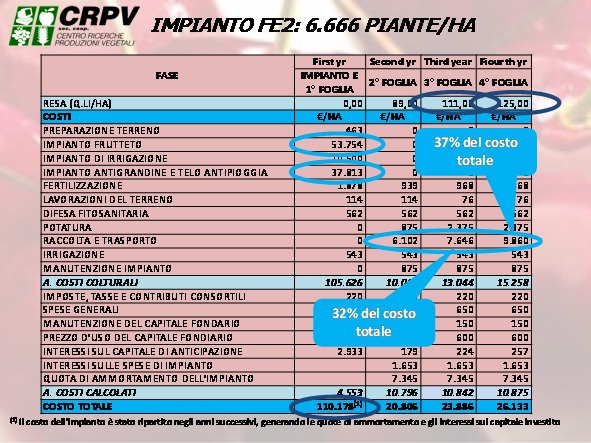High density sweet cherry orchards
The strategy behind the intensive high density cherry orchards is to decrease the operational costs combined with an increase of fruit quality resulting in a higher financial return. This required a complete and integrated concept for orchard planning, tree design in terms of selection of varieties, root stock and optimal combination, plant density, pruning technique….
The first trials with the system started in Italy about 10 years ago. First objective was to improve fruit quality as smaller cherries are not paid for. Smaller fruit size means also higher picking costs and with a total cost of around 12.5 €/h the cherry productivity of production became under heavy pressure.
Today there is a big interest in cherry production in the UK. It is most likely that in the coming years production will rise and retailers will opt more and more for the better fruit quality. Further also in UK labour costs are increasing from year to year.
In this technical note we give some information on the system. Be aware that main details in this are sometimes in conflict with traditional thinking on cherry orchards!
Reduction of operational costs
The reduction in operational costs is caused by an overall reduction in labour cost.
Reduction of picking costs
Picking from the ground: the fact that the trees are not higher than 2.5 m allow picking without ladders or mechanical platforms.
Bigger fruit size: the system achieves 90% fruit grade above 28 mm
.Per kg a 28+ grade has 60 cherries, a 24/26 grade 100 cherries. As the numbers of fruit per hour picking is fix, this results in an important increase of picking efficiency with the intensive system.
Visibility, accessibility and concentration of fruit: the "fruit wall" system further increases picking efficiency.
Reduction in pruning costs
Pruning of the trees can easily be done from the ground, allowing higher efficiency.
Pruning of high density cherry trees goes fast and does not need highly qualified labour.
VARIETIES
The varieties used in the intensive high density orchard have a combination of characteristics required for the market and for the tree structure.
Kordia
Czech variety with an “easy” tree structure. Productive with good fruit size. Not sensitive for cracking. Midseason. Sensitive to frost. Pollinators necessary: Regina and/or Schneider. Taste panels give Kordia a top ranking!
Regina
German variety with easy tree structure. Crops well and consistently on Gisela 5. Late season. Very resistant to cracking. Pollinators necessary: Kordia and Schneider.
Schneider
Very productive variety with good quality but sensitive for cracking. Excellent pollinator. In general in the orchard the 3 mentioned are combined: 1/3 Kordia, 1/3 Regina, 1/3 Schneider.
Root stocks
At present Gisela 5 appears to give optimal results for the system. Gisela 5 guarantees enough vigour required for the production of multiple strong 1 yr shoots. The high density planting from the other side gives a reduction in growth so that covered crops are possible.
Pruning
Pruning is done in the winter and at the end of the summer. This pruning is very easy but the exact timing of the summer pruning is essential. We advise growers on this optimal moment. The first year after planting the first objective in pruning is to correct the tree to have closely spaced internodes. For this reason circular incisions are made.
Economics
With now 10 years experience with the system we have numerous economic data based on farm records! The fact that the orchard comes into production already the second year is resulting in a short payback period for the investment. In Italy with a 5 yr average price of 3.6 €/kg this payback period is 5-6 years. In UK conditions with better prices this payback period will be considerably shorter. We give you an idea of the involved costs and yields with Schneider, based on date from one of our growers in Ferrara. In the costs the investment for a covering of the crop is included.
